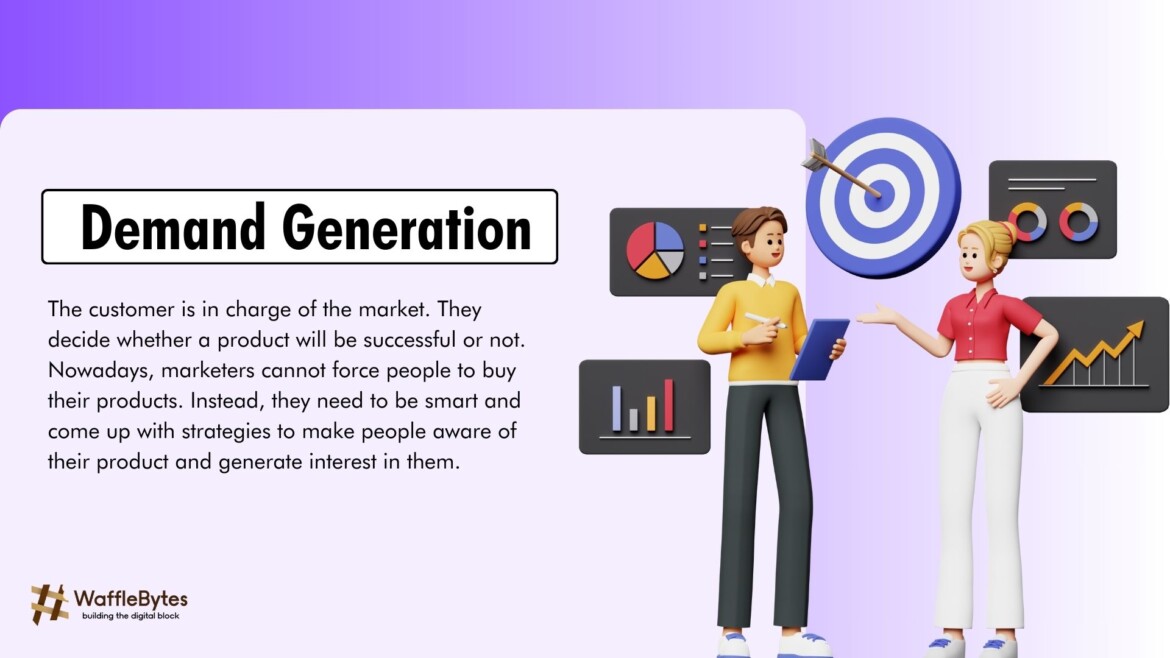The customer is in charge of the market. They decide whether a product will be successful or not. Nowadays, marketers cannot force people to buy their products. Instead, they need to be smart and come up with strategies to make people aware of their product and generate interest in them.
This has given rise to a new idea called “demand generation”. Marketers plan the entire process where they think about the customer journey. This journey starts when the customer first hears about the brand and continues until they become a customer, and hopefully a repeat customer.
What is Demand Generation?
Demand generation means creating awareness, interest and desire for a product. This involves coordinating communications at every step of the buyer’s journey.
All departments work together to deliver the brand to the target customer. The goal is to guide the customer from being unknown to becoming a happy customer.
In demand generation, marketers understand the needs of customers, study their journey, and strategically place the product at each stage. Increased visibility and clever product placement create awareness, increase interest, and lead to choice, preference, conviction, and ultimately purchase.
A good demand generation strategy focuses on these seven stages: awareness, knowledge, liking, preference, conviction, purchase, and post-purchase.
Why Demand Generation is Important?
In a market saturated with similar products and 5,000 ads per day, traditional advertising alone is not enough. This is where demand generation begins.
The purpose of demand generation is to establish a specific product in the mind of the customer. The goal is that when they consider purchasing from that industry, they will choose that particular product that has been strategically placed in their awareness.
This strategy is effective because it aligns with every step of the customer’s purchasing journey. It not only promotes the brand but also collects important data, which helps the company to improve the product.
Identifying Buyer’s Persona
To start demand generation, it is important to know the target audience well. This includes understanding their demographics, behaviour, preferences and problems. Creating a buyer persona helps to understand the audience and their challenges more effectively.
Create Awareness
After understanding the buyer’s journey, the company communicates strategically at each stage. In the awareness stage, the focus is on introducing the brand. Inbound strategies like SEO, public relations, word of mouth, and social media marketing as well as outbound strategies like advertising and lead generation play a role in building brand awareness.
Generate Interest
In the interest stage, the company emphasizes when the customer shortlists potential brands. Outbound strategies, including targeted ads, highlight unique selling points, features, offers and discounts. Inbound strategies, such as lead nurturing, also contribute to generating interest, which leads to preferences, conviction, and ultimately sales.
Driving Conversion
The purpose of this phase is to simplify and enhance the customer experience. Happy customers may share the brand, which will increase awareness. Encouraging users to share for discounts not only delights them but also expands the brand’s reach within their network.
Catering to Existing Customers
Satisfied customers increase demand. This step involves making sure existing customers are satisfied and offering special benefits for referrals. It combines referral and word-of-mouth marketing strategies, creating a positive cycle of customer satisfaction and brand promotion.
Demand Generation vs Lead Generation
Despite common confusion, demand generation and lead generation are different aspects of marketing.
Lead Generation:
- Integral part of demand generation strategy.
- Focuses on gathering and nurturing leads to drive transformation.
Demand Generation:
- Comprehensive marketing concept.
- Focusing on the buyer’s journey, both inbound and outbound strategies are employed to create awareness, generate interest, and drive more sales.

